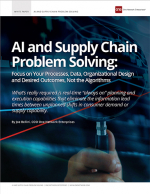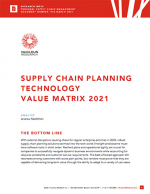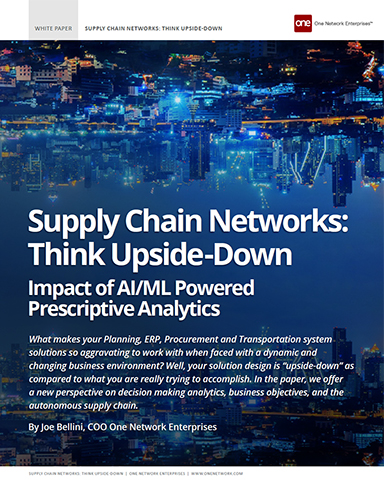Supply Chain Networks: Impact of Artificial Intelligence Machine Learning Prescriptive Analytics
In this white paper, we offer a new perspective on decision-making analytics, business objectives, and the autonomous supply chain.
Impact of Artificial Intelligence or Machine Learning Powered Prescriptive Analytics
What makes your Planning, ERP, Procurement, and Transportation system solutions so aggravating to work with when faced with a dynamic and changing business environment?
Well, your solution design is “upside-down” as compared to what you are really trying to accomplish.
Let's Flip the Equation
Anyone who has any type of artificial intelligence or machine learning (AI/ML) initiative in place has already turned their problem-solving approach upside-down.
Prior to ML, we basically had to fine-tune various types of mathematical equations to give us a near-optimal result. The independent variables were the math equations and the fine-tuning was very situational and problem-type specific.
Let’s turn this upside-down and instead of the data as the dependent variable, let’s make it the independent variable. This is what machine learning is all about.
Here the data defines the relationships and thus the equations. It is a little scary in the sense that not many people really understand the nature of the relationships that are built within ML, but the outcomes speak for themselves.
Avoid the Traps
Don’t be fooled by software vendors pretending to have this advanced analytic capability through a slick user interface or a common data warehouse.
This goes to the core of treating every single business variable across your supply network as dependent, accessible, and changeable based on your targeted outcomes.
And don’t fall into the trap of letting your software solution provider lock you into process configuration and customization that will then drive poor performance and rigidity for your business.
Instead, turn it upside-down with an AI-powered real-time demand and supply software network that will let you set the business outcomes you want to achieve, and provide you with a series of prescriptive workbenches across demand, supply, logistics, and fulfillment that will optimize your decision-making based on targeted outcomes.
Upside-down, outcome-driven solution designs will become the new normal for all business operating and trading networks in all industries over the next 10 to 15 years.
Don’t get left behind. - Download the White Paper Now!
What’s Related




Favorites





